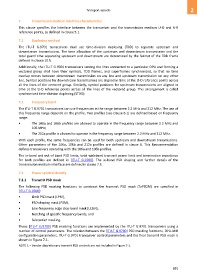Page 701 - 5G Basics - Core Network Aspects
P. 701
Transport aspects 2
7 Transmission medium interface characteristics
This clause specifies the interface between the transceiver and the transmission medium U-O and U-R
reference points, as defined in clause 5.1.
7.1 Duplexing method
The ITU-T G.9701 transceivers shall use time-division duplexing (TDD) to separate upstream and
downstream transmissions. The time allocation of the upstream and downstream transmission and the
total guard time separating upstream and downstream are determined by the format of the TDD frame
defined in clause 10.5.
Additionally, the ITU-T G.9701 transceivers serving the lines connected to a particular DPU and forming a
vectored group shall have their symbols, TDD frames, and superframes synchronized, so that no time
overlap occurs between downstream transmission on any line and upstream transmission on any other
line. Symbol positions for downstream transmissions are aligned in time at the U-O reference points across
all the lines of the vectored group. Similarly, symbol positions for upstream transmissions are aligned in
time at the U-O reference points across all the lines of the vectored group. This arrangement is called
synchronized time-division duplexing (STDD).
7.2 Frequency band
The ITU-T G.9701 transceivers can use frequencies in the range between 2.2 MHz and 212 MHz. The use of
this frequency range depends on the profile. Two profiles (see clause 6.1) are defined based on frequency
range:
• The 106a and 106b profiles are allowed to operate in the frequency range between 2.2 MHz and
106 MHz;
• The 212a profile is allowed to operate in the frequency range between 2.2 MHz and 212 MHz.
With each profile, the same frequencies can be used for both upstream and downstream transmissions.
Other parameters of the 106a, 106b and 212a profiles are defined in clause 6. This Recommendation
defines transceivers operating with the 106a and 106b profiles.
The in-band and out of band PSD limits, total wideband transmit power limit and termination impedance
for both profiles are defined in [ITU-T G.9700]. The in-band PSD shaping and further details of the
transmission medium interface are defined in clause 7.3.
7.3 Power spectral density
7.3.1 Transmit PSD mask
The following PSD masking functions to construct the transmit PSD mask (TxPSDM) are specified in
[ITU-T G.9700]:
• Limit PSD mask (LPM),
• PSD shaping mask (PSM),
• Low-frequency edge stop-band mask (LESM),
• Notching of specific frequency bands, and
• Subcarrier masking.
These [ITU-T G.9700] PSD masking functions are implemented by the ITU-T G.9701 transceivers using a
number of control parameters. The relation between the [ITU-T G.9700] PSD masking functions, DPU-MIB
configuration parameters, ITU-T G.9701 transceiver control parameters and the final transmit PSD mask is
shown in Figure 7-1.
NOTE 1 – Vendor discretionary transmit PSD controls are not included in Figure 7-1.
691

